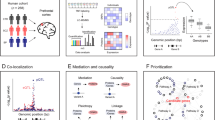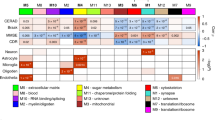Abstract
Comparative brain proteome analysis is a new strategy to discover proteins and therefore genes whose altered expression may underlie schizophrenia. This strategy does not require an a priori theory of the pathogenesis or the mode of inheritance of schizophrenia. Using proteome analysis we previously compared the hippocampal proteome, that is, those proteins expressed by the hippocampal genome, of seven schizophrenic individuals with the hippocampal proteome of seven control individuals, matched for age and post mortem delay.1 We found 18 proteins that were significantly altered in concentration in the schizophrenic hippocampus (P < 0.05), when compared to control tissue. One of these proteins was characterised, by N-terminal sequencing, as diazepam binding inhibitor whose gene maps to 6q12–q21. Here we characterise a further three of the 18 proteins as: manganese superoxide dismutase, 6q25.3, T-complex protein 1, 6q25.3–q26 and collapsin response mediator protein 2, 8p21. That three of these four characterised proteins should map to the long arm of the same chromosome is significant (P < 0.002) and suggests the importance of chromosome 6q in schizophrenia. These results indicate that antioxidant defence is altered in the schizophrenic hippocampus and suggest that segregation distortion, of schizophrenia susceptibility genes, may be a possible causative factor in the high incidence of schizophrenia.
This is a preview of subscription content, access via your institution
Access options
Subscribe to this journal
Receive 12 print issues and online access
$259.00 per year
only $21.58 per issue
Buy this article
- Purchase on Springer Link
- Instant access to full article PDF
Prices may be subject to local taxes which are calculated during checkout


Similar content being viewed by others
References
Edgar PF, Schonberger SJ, Dean B, Faull RLM, Kydd R, Cooper GJS . A comparative proteome analysis of hippocampal tissue from schizophrenic and Alzheimer's disease individuals Mol Psychiatry 1999; 4: 173–178
Wasinger VC, Cordwell SJ, Cerpa-Poljak A, Yan JX, Gooley AA, Wilkins MR et al. Progress with gene-product mapping of the mollicutes: Mycoplasma genitalium Electrophoresis 1995; 16: 1090–1094
Yan JX, Tonella L, Sanchez J, Wilkins MR, Packer NH, Gooley AA et al. The Dicryostelium discoideum proteome—the SWISS 2DPAGE database of the multicellular aggregate (slug) Electrophoresis 1997; 18: 491–497
Wilkins MR, Williams KL, Appel RD, Hochstrasser DF . Proteome Research: New Frontiers in Functional Genomics Springer Verlag, Berlin Heidelberg 1997
Reveley AM, Reveley MA, Clifford CA, Murray RM . Cerebral ventricular size in twins discordant for schizophrenia Lancet 1982; 11: 540–541
Weinberger DR . Schizophrenia. From neuropathology to neurodevelopment Lancet 1995; 346: 552–557
Melov S, Schneider JA, Day BJ, Hinerfeld D, Coskun P, Mirra SS et al. A novel neurological phenotype in mice lacking mitochondrial manganese superoxide dismutase Nature Genet 1998; 18: 159–163
Loven DP, James JF, Biggs L, Little KY . Increased manganese-superoxide dismutase activity in postmortem brain from neuroleptic-treated psychotic patients Biol Psychiatry 1996; 40: 230–232
Yamada K, Kanba S, Anamizu S, Ohnishi K, Ashikari I, Yagi G et al. Low superoxide dismutase activity in schizophrenic patients with tardive dyskinesia Psychol Med 1997; 27: 1223–1225
Huret JL, Delabar JM, Marlhens F, Aurias A, Nicole A, Berthier M et al. Down syndrome with duplication of a region of chromosome 21 containing the CuZn superoxide dismutase gene without detectable karyotypic abnormality Human Genet 1987; 75: 251–257
Lethem R, Orell M . Antioxidants and dementia Lancet 1997; 349: 1189–1190
Arnold SE, Trojanowski JQ . Cognitive impairment in elderly schizophrenia: a dementia (still) lacking distinctive histopathology Schizophr Bull 1996; 22: 5–9
Mena I, Marin O, Fuenzalida S, Cotzias GC . Chronic manganese poisoning Neurology 1967; 17: 1123–1129
Goodman AB . Elevated risks for amyotrophic lateral sclerosis and blood disorders in Ashkenazi schizophrenic pedigrees suggest new candidate genes in schizophrenia Am J Med Genet 1994; 54: 271–278
Rosen DR, Siddique T, Patterson D, Figlewicz DA, Sapp P, Hentati A et al. Mutations in Cu/Zn superoxide dismutase gene are associated with familial amyotrophic lateral sclerosis Nature 1993; 362: 59–62
Yaffe MB, Farr GW, Miklos D, Horwich AL, Sternlicht ML, Sternlicht H . TCP1 complex is a molecular chaperone in tubulin biogenesis Nature 1992; 358: 245–248
Fananas L, Bertranpetit J . Reproductive rates in families of schizophrenic patients in a case-control study Acta Psychiatrica Scand 1995; 91: 202–204
Dorak MT, Burnett AK . Major histocompatablility complex, t-complex, and leukemia Cancer Causes & Control 1992; 3: 273–282
Figueroa F, Vincek V, Kasahara M, Bell GI, Klein J . Mapping of the Sod-2 locus into the t complex on mouse chromosome 17 Immunogenetics 1988; 28: 260–264
Goshima Y, Nakamura F, Strittmatter P, Strittmatter SM . Collapsin-induced growth cone collapse mediated by an intracellular protein related to UNC-33 Nature 1995; 376: 509–514
Kamata T, Subleski M, Hara Y, Yuhki N, Kung H, Copeland NG et al. Isolation and characterisation of a bovine neural specific protein (CRMP-2) cDNA homologous to unc-33, a C. elegans gene implicated in axonal outgrowth and guidance Brain Res Mol Brain Res 1998; 54: 219–236
Costa E, Guidotti A . Diazepam binding inhibitor (DBI): a peptide with multiple biological actions Life Sci 1991; 49: 325–344
Kammen DPv, Guidotti A, Neylan T, Guarneri P, Kelley ME, Gurklis J et al. CSF levels of diazepam-binding inhibitor correlate with REM latency in schizophrenia, a pilot study Eur Arch Psychiatrys &s Clin Neurosci 1994; 244: 216–222
Cao Q, Martinez M, Zhang J, Sanders AR, Badner JA, Cravchik A et al. Suggestive evidence for a schizophrenia susceptibility locus on chromosome 6q and a confirmation in an independent series of pedigrees Genomics 1997; 43: 1–8
Altschul SF, Madden TL, Schäffer AA, Zhang J, Zhang Z, Miller W et al. Gapped BLAST and PSI-BLAST: a new generation of protein database search programs Nucleic Acids Res 1997; 25: 3389–3402
Sharp CW, Muir WJ, Blackwood DH, Walker M, Gosden C, Clair DMS . Schizophrenia and mental retardation associated in a pedigree with retinitis pigmentosa and sensorineural deafness Am J Med Genet 1994; 54: 354–360
Johnson JP, Muhleman D, MacMurray J, Gade R, Verde R, Ask M et al. Association between the cannabinoid receptor gene (CNR1) and the P300 event-related potential Mol Psychiatry 1997; 2: 169–171
Roth BL . Multiple serotonin receptors: clinical and experimental aspects Ann Clin Psychiatry 1994; 6: 67–78
Ruiz A, Borrego S, Marcos I, Antinolo G . A major locus for autosomal recessive retinitis pigmentosa on 6q, determined by homozygosity mapping of chromosomal regions that contain gamma-aminobutyric acid-receptor clusters Am J Hum Genet 1998; 62: 1452–1459
Fink G, Sumner BEH . Oestrogen and mental state Nature 1996; 383: 306
Acknowledgements
This work was supported by grants from the Health Research Council (NZ), The Foundation for Research Science and Technology (NZ), The Oakley Trust and The Schizophrenia Fellowship of NZ. Brain tissue was kindly provided by the NZ Neurological Foundation Human Brain Bank, Department of Anatomy with Radiology, University of Auckland, New Zealand.
Author information
Authors and Affiliations
Corresponding author
Rights and permissions
About this article
Cite this article
Edgar, P., Douglas, J., Cooper, G. et al. Comparative proteome analysis of the hippocampus implicates chromosome 6q in schizophrenia. Mol Psychiatry 5, 85–90 (2000). https://doi.org/10.1038/sj.mp.4000580
Received:
Revised:
Accepted:
Published:
Issue Date:
DOI: https://doi.org/10.1038/sj.mp.4000580
Keywords
This article is cited by
-
The DPYSL2 gene connects mTOR and schizophrenia
Translational Psychiatry (2016)
-
CRMP1 Interacted with Spy1 During the Collapse of Growth Cones Induced by Sema3A and Acted on Regeneration After Sciatic Nerve Crush
Molecular Neurobiology (2016)
-
CRMPs: critical molecules for neurite morphogenesis and neuropsychiatric diseases
Molecular Psychiatry (2015)
-
Collapsin Response Mediator Proteins Regulate Neuronal Development and Plasticity by Switching Their Phosphorylation Status
Molecular Neurobiology (2012)
-
Neuroproteomics: understanding the molecular organization and complexity of the brain
Nature Reviews Neuroscience (2009)



